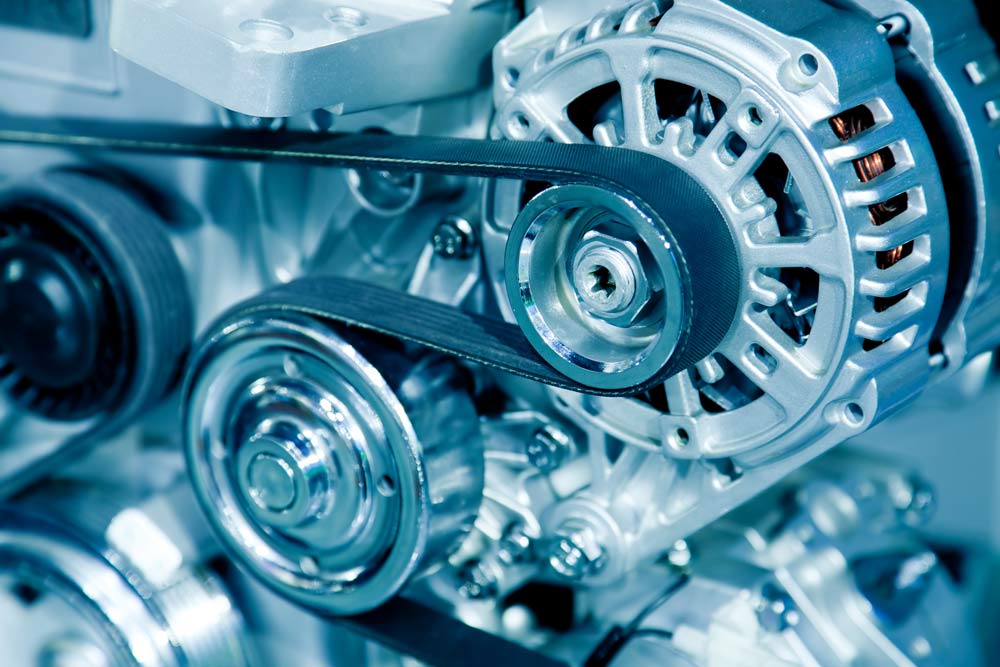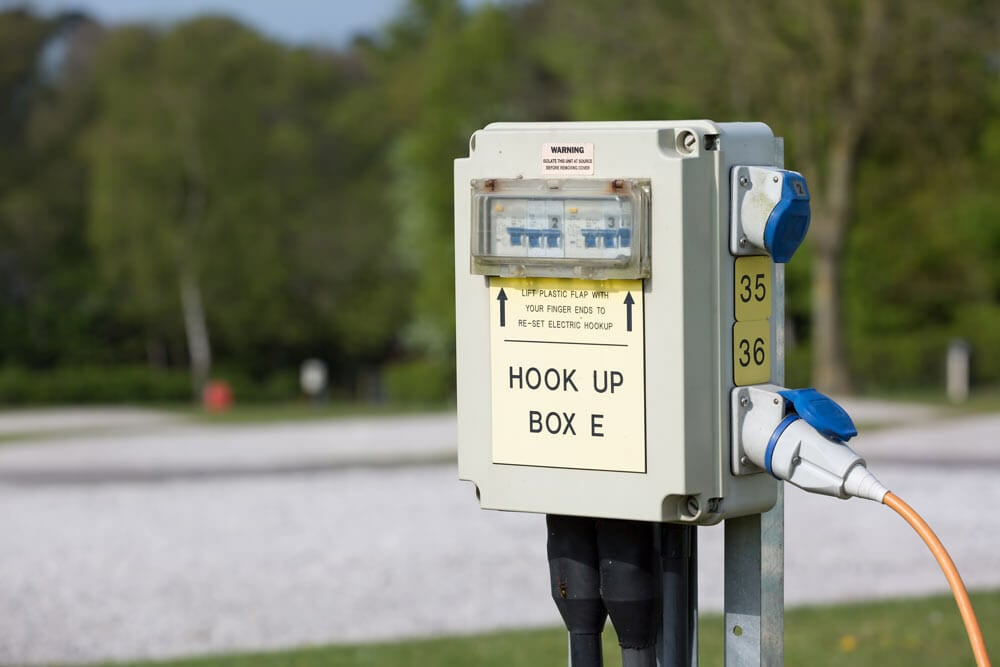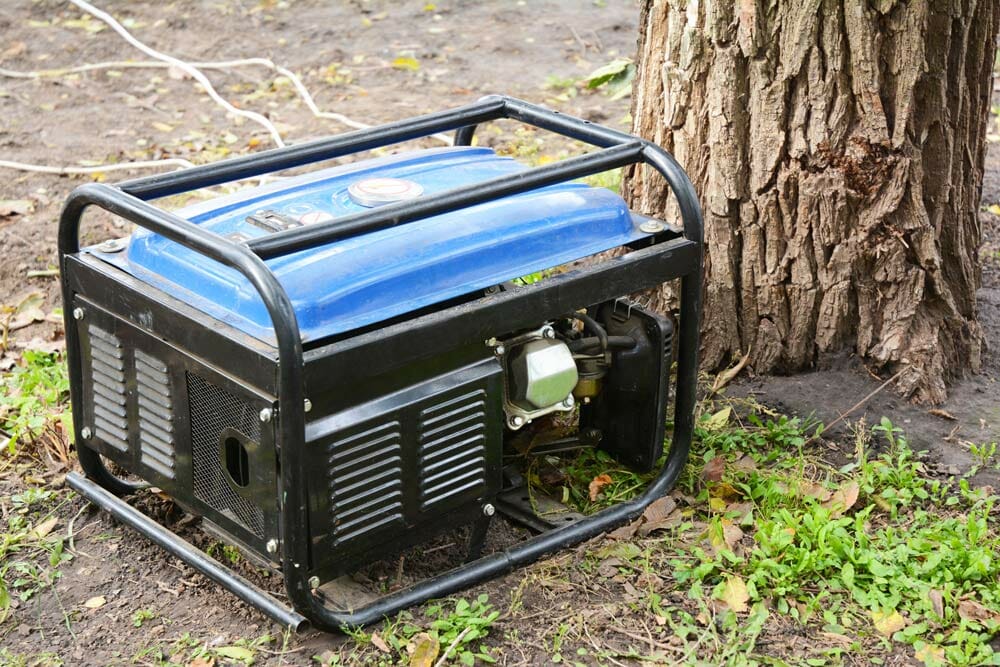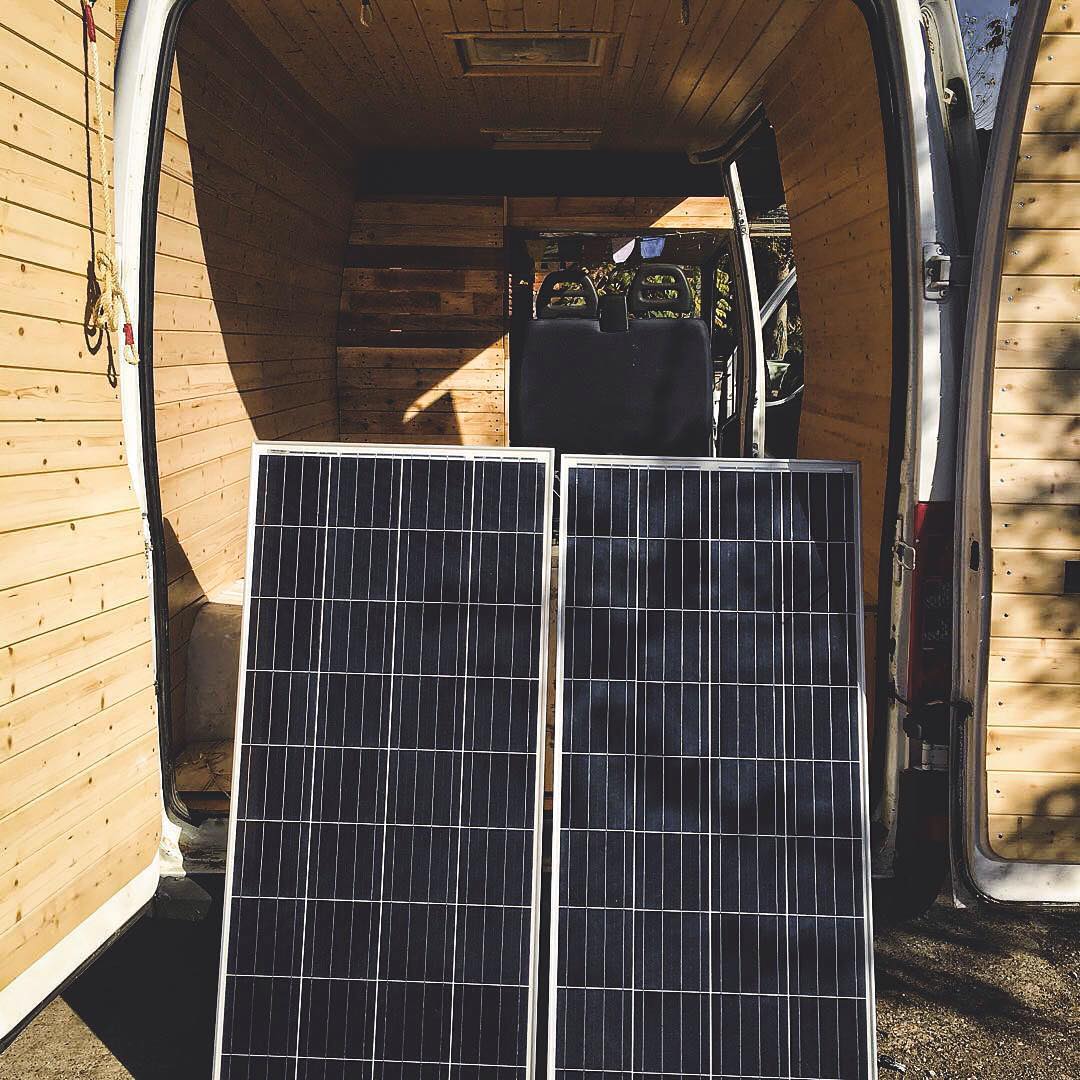How To Get Electricity In A Camper Van
When it comes to powering electronics in your campervan, there are four common ways to collect energy. These are: your vehicle’s alternator, hooking up to a campground electrical system, using a generator, or using solar panels.
The type of energy collection you choose to use will be dependent on the type of trip you are taking, budget, and location.
We’ll cover:
- Alternators
- RV Hookups
- Generators
- Solar Power

Powering Electronics With Your Vehicle’s Alternator
Powering electronics using your van’s current electrical system is a straightforward solution. People can charge their phones while driving, so why not just use those same systems for all of your electronics? Well, the challenge comes when you turn the car off.
What is an alternator?
An alternator is a little component that is bolted to the engine with a wheel on it. As you drive, one of the belts on your engine spins that wheel to generate electricity. This is similar to making electricity from a spinning windmill or a hydro generator. The electricity from the alternator powers all of the lights, radio, controls and things in your car. It also charges your starting battery.
The cigarette lighter in your car is a 12 volt socket connected to the starting battery. The car’s alternator has plenty of power to keep the starting battery topped off and charge some devices through this 12V socket. The problem comes when you turn car off. There is no longer alternator power going to your starting battery and it will drain relatively quickly, making it so you can’t turn the car back on when you want to.
You can read more about this in our post on battery basics.
Recharging a secondary battery with the car’s alternator
The simplest and cheapest way to get power is to use this existing alternator to charge a second battery. The alternator has plenty of extra power you can tap into while you’re driving. This method works well for a small electrical system or even better combined with some of the other energy collection methods. Some notes:
- Vehicle alternators aren’t designed for charging deep-cycle batteries. They are mainly meant for topping off the starting battery. This means that a deep-cycle battery will not be getting a full charge cycle from the alternator. You can live with this and finish the charge cycle with solar, or spend more on a B2B charger to mitigate the problem.
- Using an alternator to charge a secondary battery requires that you drive the van! For even basic power needs (laptop and lights), you will need to drive for a decent amount of time on a daily basis if you’re relying on it for your electrical needs. On the flipside, if you’re traveling frequently it’s a great option.
- It’s not good to let the car idle to charge your batteries. Not only do alternators perform best at higher engine speeds, they are incredibly inefficient relative to a generator. More importantly, this is hard on the car. Without moving through the air and varying engine speeds, your motor is not operating with optimum cooling or oil pressure. Over the long term, this is quite hard on the motor and shouldn’t be done regularly.
Some of these problems can be solved by buying an aftermarket alternator or pulley wheels. There are larger alternators for many vehicles that provide significantly more power and you can tune them to work at lower engine speeds. If you are commuting in your van every day you might as well use the power that is available. Some people only need 15 minutes of extra juice for an electric stove and an alternator can provide that.
Hooking a deep-cycle battery to the alternator
There are safe ways of hooking up a deep-cycle battery. Using a B2B charger is best, but it can be done cheaper with a manual switch or isolator. Check out our B2B and Battery Isloator posts for more details on setup.
The bottom line is that most people looking to put electrical in a van benefit from a generator, solar panels, or RV hookups. We don’t recommend relying solely on the alternator if you plan on staying in one location for multiple days.

Using RV Hookups To Power A Van
If you’ve got the means, paid campsites with electrical hookups can be one of the best choices out there. This energy source is clean, quiet, and can power high-demand amenities such as microwaves and air conditioners. Staying in an RV park or campsite with electrical hookups can cost as little as $20 per night or as much as a hotel room.
Before going out and spending a few hundred dollars on solar panels, it might be worth looking into how often you might stay at an RV park. If you are planning to travel for only a short period of time or require 24/7 hookups, an RV park may be the best option for you. A popular combination is an RV hookup and a backup generator as the systems share many components and it is easy to switch between the two.
Shore power basics
Electrical power from the grid is often referred to as shore power. The term shore power comes from the marine world. Boats dock at the shore and plug into the electric grid. This is because their engines, which usually provide the power at sea, are turned off.
There are two ways most people use shore power in a van: direct connection, and charging a secondary battery.
Connecting directly to shore power
Shore power coming out of an outlet in the U.S. produces 110-volts of alternating current (AC) energy; The same type of energy used in your house. An easy way to make use of shore power is to simply plug electronics directly into the outlet. Bring an extension cord along to power things within the van. This is a surprisingly effective method for those on a budget. If you find a cheaper campsite you can charge your devices, take a shower and fill your water for $20. On the road you can charge several devices at a time using libraries or coffee shops.
If you want to get more involved with your install, it’s possible to wire a breaker box and outlets in your van. This is how RV’s connect in campsites. One large plug goes from the campsite into your van and it is then spread to smaller household plugs. This method is more advanced so we recommend you have some experience with electricity or have a pro install the system if you do decide to go that route. Usually only larger vehicles use this method and it is paired with a smart charger and battery bank.
Charging a secondary battery
The other way to use shore power at a campsite or RV park is by charging a secondary battery. The secondary battery can then be used to charge your devices after leaving the campground, or at a later time.
Most batteries are best stored at 100% charge. Both overcharging, and undercharging a battery will wear it out over time. A smart battery charger will keep your battery healthy and keep you safe. If you are planning to frequent electric sites and power up a secondary battery, a proper charger is a must. Make sure to get one specifically for your battery type and that can output enough Amps to properly charge. Some people make the mistake of buying a $50 trickle charger which will undercharge and wear out your battery.
If you are going this route, we recommend reading more about batteries and chargers in our post on battery basics.

Powering Your Camper Van With A Generator
Many vanlifers power their electronics with a generator. Generators are a practical solution because they can create consistent electricity at night or in bad weather (unlike solar panels).
They can also be easily moved around making you less location dependent (unlike shore power). When it comes to power, generators can pack quite a punch. If you are planning to use a large amount of electricity then having a generator will allow you to run things like an air conditioner, microwave or electric heater. That type of power capacity is impractical for solar. Generators are also an excellent backup option if you are using solar power and run into a couple of weeks without sunny skies.
Generators use a gas or diesel-powered engine to produce electricity. This is done through an on-board alternator. Unlike your car motor, they are designed to run in place for extensive periods of time and for the sole purpose of producing electricity.
Generator storage and safety
Because generators run using gas, it will be necessary to carry extra gas containers on your road trip journey. Gasoline needs to be highly ventilated when stored- the same is true for a generator. Generators and their fuel are commonly mounted to outside of the vehicle. Most vanlifers choose to mount the generator and fuel tanks on the back of the van nearer to the gas tank. Some more dedicated builds mount the generator inside the van, but sealed off from the interior and vented to the outside similar to an RV.
Generators are a major carbon dioxide risk and should never be used inside a vehicle. In fact, there is an entire website dedicated to this notion called takeyourgeneratoroutside.com. Mounting the generator to the back of the van also makes it an easy process to ‘set it and forget it’ when traveling.
Generators take up a lot of space and can be pretty heavy when full of fuel. Keep this in mind when determining where to store a generator. For instance, mounting a generator on the will be making your van top-heavy and filling the generator with fuel is going to be a challenge.
Choosing a generator for vanlife
Choosing a specific generator is going to be dependent on your electric needs. Some of the most popular portable generators brands are Yamaha, Honda and Ryobi.
Most vanlifers decide to purchase a 2,000 Watt generator. Calculate how much energy you plan to use to help determine which generator is best for you. The initial cost of a small portable generator will run between roughly $700-$1,000. The ongoing costs vary.
Most generators include a combination of both AC (household plugs) and DC (cigarette and USB) electric options making it easy to charge all of your household items and electronics. A 1000W generator is probably ideal for powering lights, fans, laptops, phones and other small accessories. If more power is needed for a refrigerator, water heater, or air conditioner, you will probably want to look into a 2000W generator.
Charging up a spare battery with a generator
One of the downsides to using a generator is it has to constantly be on in order to get power. Do not expect to run a refrigerator or anything 24/7 off a generator unless you intend to keep it outside and running the entire time.
Generators make noise while running- even the quiet ones. This limits where you can run them and severely limits your ability to hide that you’re living in a van if that is your intention. It is common to run the generator for a few hours while charging up a spare battery with a smart charger. Then using that spare battery to power electronics when the generator is off. Read our post on battery basics for more information on which battery types to use.

Powering Your Van With Solar Panels
Solar panels are at the forefront of of power collection options for vandwellers. Solar panels can be a great solution for someone living in a van because the power is clean, minimal, makes no noise, and the cost of solar has gone down significantly in the past few years.
Solar has a high up-front cost and is a bit more technical to install (see these wiring diagrams). It is also not as consistent of a power source. For vandwellers who are able to change their electrical use on a daily basis this isn’t a major hurdle, but for those who rely on power for essential items then backup plans should be considered
Solar power is such a fun subject that we’ve got several posts that lay out all of the parts. If you want to know more, you can start with a our 200 Watt Van Solar Setup and branch out from there.
What If I Put A Windmill On Top Of My Van?
As long as we’re talking about renewable energy, why not? It could even be mounted to charge while driving. Unfortunately, this will never be an efficient electricity solution for vanlife for two reasons:
- Windmills need to be up high in the air-stream to get to a nice consistent spin. High enough that you’ll need to be running cables and anchoring it down.
- If you want to get energy from driving, your alternator can already do that without the drag inefficiencies of trying to push a giant blade through the air. Windmills generate electricity from the wind pushing against them, so when you’re driving then you are pushing the car through the air. Which is spending more money on gas than you’re gaining in watts.

Thanks for this information; excellent! Here’s my situation and question: I have 2, 6v batteries wired in series; the batteries are rated at 224 amp hrs. My energy consumption is about 50 amp hrs per day. How many days do you estimate I should go before I need to drive to recharge these deep cycle batteries, or plug in? Also, I’m considering installing 1 Zamp 100w solar panel. So if I divide 100w by 12, I get 8.33 amp hrs; but I have no clue what this means. Not sure what this contributes to my battery storage, or if it’s even reasonable that I get a solar panel. Can you help me understand, and decide? Thanks, pat
Pat: When you wire in series the voltage increases but the amp hours stay the same. This means that you have total a 12V, 224Ah battery bank. Lead acid batteries shouldn’t be discharged below 50% on a regular basis, which means that you have about 112Ah of readily available battery. So you can go a little more than two days with no charge if you’re using 50Ah per day.
You’re almost there with the solar. 100W/12V= 8.33 amps. This means that in full sun it’s putting out 8.33 amps, so multiply that by amount of hours in the sun and you’ll get how many amp hours it’ll put in your battery. Say the panels are in the sun for 5 hours. 8.33A x 5 hours = 41.65 amp hours. That’s the basic equation.
The last thing you need to remember is that charge controllers aren’t 100% efficient. a PWM charge controller is about 80% efficient (meaning you get 80% of the power from the panels into the batteries). A MPPT is about 92% efficient. So instead of 8.33 amps, you’re getting closer to 8.33 x .8 = 6.5 amps. Running the equation again, a 100W solar panel will get you 6.5A x 5 hours = 32.5 Amp hours of charge with the 5 hours of sun. If you’re in Arizona you may be getting seven hours of sun, and if you’re in Seattle it might be closer to three.
In my opinion if you’re using 50Ah daily you’re probably going to want 200W of solar. Especially because you have the battery bank to support it! Driving helps, but standard alternators typically don’t put out more than 10-15amps of charge into deep cycle batteries. Even a 90Amp alternator regulates itself to not overcharge your car battery. So to get 50Ah from your alternator you need to drive for at least 3 hours. Hope this helps your figure it out!
Ian,
I really appreciate you for taking the time to answer my question so thoroughly. Very helpful!
Hi Ian,
Firstly, thanks so much for your detailed posts. Its immensely helpful and written in such a clear way. Well done.
I’m considering the Renogy Solar kit and have gone through your checklist to work backwards and first determine power consumption needs. I’m not going to be using propane but rather an electric stovetop solution and I’d also look to use heating solution as well as a Maxxair fan that I’ve already installed. Long story short, my numbers come out to be a worst case scenario of 110ah per day. Seems high, but I’ve heard that you should double or even triple the estmate to get the wattage need in terms of panels.
Where I am there’s an avg of 3-5 hours of sunlight.
This is the guy I’m looking at but with 2 deep-cycle AGM 12v 200ah batteries. https://www.renogy.com/renogy-300-watt-12-volt-premium-solar-complete-kit/#tab_prd-specs
Given the above info, does anything sound horribly out of whack to you? Would x2 100W panels suffice instead of 3 in your opinion?
Any advice would be appreciated.
Thanks so much again for all the details on your site.
Cheers
William- for the numbers that you gave I’d think you have too much battery/solar ratio. For 300W of solar, I’d usually want around 200ah of lead-acid battery for a van. At 300W you’re going to bet getting around 100Ah of sun per day. (300W x 12 hours = 1200Wh. 1200Wh / 12V = 100Ah). So unless you have a large external source of energy, you’ll only be able to replace about 100Ah of your available 200Ah of battery per day. And for batteries you typically want to charge them to 100% at least a couple of times a week. Every day is better. If they sit below 100% their lifespan will shorten significantly.
The other thing you want to remember is that it’s also hard on batteries if you charge them too slow. This depends on the specific battery, but it’s good to hit at least a C/12 charge rate. C = Total capacity of your battery bank (in amp hours). So if you have 2 x 200Ah batteries, your capacity is 400Ah. C=400. So in this case, you want to charge at least at 400/12 = 33A rate. With 300W of solar, you’r charging at 300/12 = 25A rate. So you’d need more solar just to charge fast enough to keep the batteries healthy, and that’s aside from not filling the bank enough. I think in your scenario a 200Ah battery fits much better with 300W of solar and should be enough for an induction burner. A heater is a different issue, though. Those take a lot of battery power to be useful (unless you’re using it to power the fan of a diesel heater or something)
https://www.amazon.com/PowerSurvival-Generator-1230-Watt-Enerplex-80-Watt/dp/B07DPBY4GZ/ref=sr_1_2?s=lawn-garden&ie=UTF8&qid=1533861003&sr=1-2&keywords=1230-Watt+Enerplex
Looks like a good solar starter option for the money
It doesn’t look bad, does it! I’m not familiar with the PowerSurvival power stations, but these types of things are cropping up all over the place now. We’ll have to look into it and update our “solar generator” post if we find good info.
Thank you for the helpful post.
If you have some money, its better to take it to a mechanic, have him cut off one of the ends of the jumper cables and crimp on ring connectors. Then have him drill a hole through the floor and thread the end through it, under the frame, and up to the starting battery.
Hi Ian,
So we have converted a van and have set up a battery 12v bank for our power needs. The bank contains two 155 Ah 12v deep cycle batteries wired in parallel. We have four 100w renogy solar panels hooked in to charge them up. We also have the standard sprinter van alternator hooked in to charge them as well. Then a 2000w inverter hooked in also. We understand they are both the solar and alternator are trickle chargers but thought they would produce more power. We also live in Columbus Ohio so we think we just don’t get enough sun, especially in the winter. Many people get by with 100-200w of solar. Any recommendations? I am considering buying a battery tender to top them up to 100% as needed.
Zaan-
It’s difficult do try to diagnose these things over the internet without seeing your setup. It could very well just be that the available sunlight in the Ohio winter isn’t enough. The sun is lower in the sky during the winter, so if your panels are mounted flat they take an extra hit to efficiency. And as you’ve probably noticed that it takes quite a bit of driving to keep the batteries charged every day.
With that said, you could still make sure your connections are all correct. It would be a good idea to get a volt meter and make sure you’re getting power from your panels.
Also, if you have an MPPT controller and not already doing so, you should try wiring your panels in series. It is usually quite easy to re-wire. Wiring in series (rather than parallel) does better in low light conditions and Ohio winters are a perfect candidate for this advantage.
Getting a battery tender will work OK, to be effective you’ll want to spend a bit more and get a battery charger. Battery tenders just maintain a charge on already healthy batteries with a small amperage capability. Go with something like this CTEK 25A charging unit.
I bought a Toyota Sean’s xle
Mortified for whee chair side loaded automatic my question is when I have my scoter in can I plug it anywhere for charging the battery
I plane to keep it inside most of the time thank you fir your time
Using solar panel about using renewable energy to do my part in reducing carbon emissions to save the planet. It has everything I need to generate power while I’m on the road, from excellent panels to an easy-to-use charge controller.